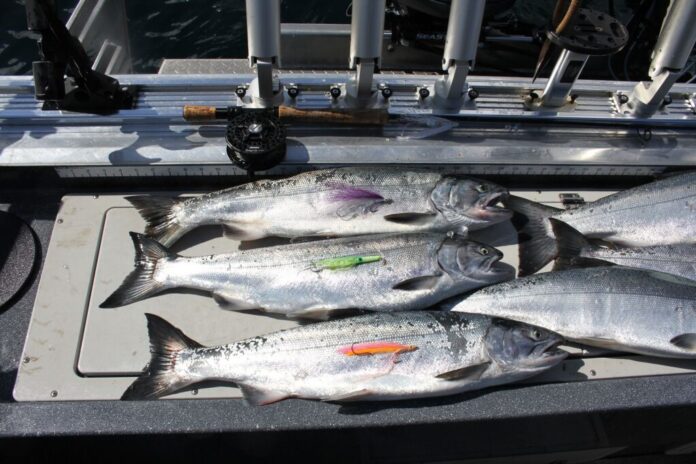Submitted by Denis Peirce
There are times and places where fish congregate and the angling can be exceptional. One of these locations is the Strait of Juan de Fuca, separating the Olympic Peninsula of Washington and Vancouver Island, British Columbia. The Strait is the funnel leading into the Puget Sound. Each year in September, the coho salmon come in from the feeding grounds of the Pacific heading for their spawning rivers. As the schools of salmon migrate through the Strait the fishing can be excellent.
The timing for the coho salmon run spans the month of September. Anglers say there are fewer but larger fish early, and as the month progresses the numbers increase and the size declines. We fished the 12th through the 17th trying to make sure if the run was early or late, we would be there for prime time. Last yea,r the Strait featured a “good” salmon run and 2022 was billed as an excellent year for coho numbers. These things can be cyclical and any given year can produce poor results.
Submitted by Denis Peirce
Last week I spent five days fishing the Strait with a group of six northern California anglers. We towed two boats to the Port Angeles area and fished sunrise to mid afternoon every day.
The first day we fished the Port Angeles area with one boat heading east and one west scouting for the salmon concentrations. The results were poor with just a handful of salmon hooked and only two legal fish put in one of the boats.
Submitted by Denis Peirce
The following morning we were up by 4 a.m. and out by 5 to trailer the boats west to the fishing village of Sekiu (pronounced see-que). The amount of boat traffic spoke volumes about the fishing out of Sekiu harbor. I could feel the excitement on the docks as everyone was hustling to get their boats in order and out of the marina. The biggest problem was finding somewhere to park the truck and boat trailer, nearly a 40 foot rig. There were in excess of 50 boats each day off Sekiu.
Once we were out of the marina it was a full speed run out to the 400′ depths. Each morning as the boat slowed to trolling speed I would send out my fly rod trolling line and without fail my fly was hit on the way out. An encouraging way to start the day. But not one of these fish was a hatchery salmon. The early morning action in low light conditions was the best of the day. For an hour or so the fish were on top. We landed roughly half of each day’s catch in the first hour or so. As the skies lightened and the overcast lifted the fish moved down and the 20 to 35 foot depth produced the most fish and the action markedly slowed down.
Submitted by Denis Peirce
The tide movement in the Strait is quite strong. If you look at a map of the Puget Sound, it is a huge area that adds or subtracts 4 to 6 feet of water every 6 hours. I “guesstimate” that there are literally cubic miles of water passing through on a daily basis. The strategy for trolling boats is to go across the current so that the fish facing into the flow can see a profile of your fly. The main caveat is not to cross the border into Canadian waters. There are angler tales of the dire consequences for fishing in Canadian waters without a license.
Submitted by Denis Peirce
The rules for this fishing require only hatchery fish may be kept and all “wild” fish must be released. The distinction being hatchery fish have their adipose fin removed. Each day at Sekiu we increased our catch. At first we were landing about two dozen fish per boat. The last two days my boat landed 32 then 42 salmon. The reason for the high number of fish caught was that the wild fish outnumbered the hatchery by a wide margin. The last day we had to land 42 in order to keep a three angler limit of six fish. At first there was grumbling about the lack of hatchery coho. I had a different opinion. I was there for the experience of hooking and playing lots of salmon. If we kept the first six fish we caught we would have been done after the first hour. I like the system Washington has in place.
Submitted by Denis Peirce
Other regulations require barbless hooks to facilitate releasing the fish. Another good rule is that wild fish can not be brought over the boat’s gunnel. They must be identified outside the boat and quickly released.
As the migration progresses these salmon will spread throughout the Puget Sound. The high concentration of them is in the Strait, which is why the fishermen flock to Sekiu in September. We tried to book a place to stay for 2023 and there was nothing available. Camping seems to be the only local solution.
Submitted by Denis Peirce
Sekiu is a very long, 20 hour drive away. But in a good year it can be as good as Alaska for coho salmon. Many thanks to Cal Harris and Jason Lai for towing their boats almost to the Canadian border for us to have another fishing adventure. Will 2023 be a good year? Only mother nature knows. For me, I am planning a return trip.
Denis Peirce writes a fishing column for The Union’s Outdoors section and is host of “The KNCO Fishing & Outdoor Report,” which airs 6-7 p.m. Fridays and 5-6 a.m. Saturdays on 830-AM radio. Contact him via his website at http://www.trollingflies.com
Submitted by Denis Peirce
Submitted by Denis Peirce
Submitted by Denis Peirce
Credit: Source link




























